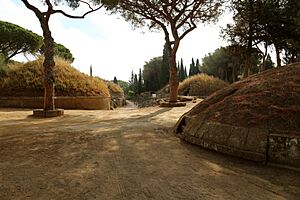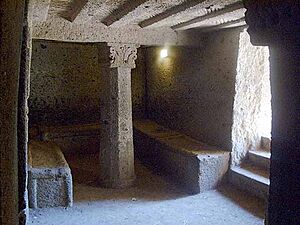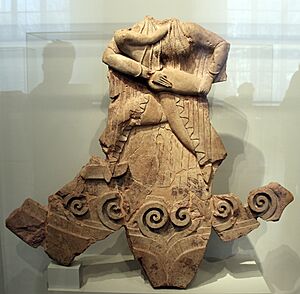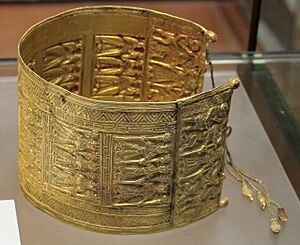Cerveteri facts for kids
Quick facts for kids
Cerveteri
|
|
|---|---|

Banditaccia Necropolis
|
|
| Country | Italy |
| Region | Lazio |
| Frazioni | Ceri, Due Casette, Furbara, Borgo San Martino, Sasso, Valcanneto, Casetta Mattei, Cerqueto, Quartaccio, Cerenova, Campo di Mare, I Terzi, San Paolo, Gricciano, Pian della Carlotta, Zambra |
| Area | |
| • Total | 134.32 km2 (51.86 sq mi) |
| Elevation | 81 m (266 ft) |
| Population
(30 November 2017)
|
|
| • Total | 37,983 |
| • Density | 282.780/km2 (732.40/sq mi) |
| Time zone | UTC+1 (CET) |
| • Summer (DST) | UTC+2 (CEST) |
| UNESCO World Heritage Site | |
| Official name | Cerveteri, Etruscan Necropolis of Banditaccia |
| Part of | Etruscan Necropolises of Cerveteri and Tarquinia |
| Criteria | Cultural: (i)(iii)(iv) |
| Inscription | 2004 (28th Session) |
| Area | 197.57 ha (488.2 acres) |
| Buffer zone | 1,824.04 ha (4,507.3 acres) |
Cerveteri is a town in the Lazio region of Italy. It is part of the Metropolitan City of Rome Capital. Long ago, the Romans called it Caere. Even before that, the Etruscans knew it as Caisra or Cisra. The Greeks called it Agylla. Its current name, Cerveteri, comes from "Caere Vetus," which means "Old Caere." This name was used in the 13th century to tell it apart from a newer town.
Cerveteri is famous for being the site of an ancient Etruscan city. This old city was huge, more than 15 times bigger than the town you see today. The most well-known part of this ancient site is the Banditaccia Necropolis.
Caere was one of the important city-states in the Etruscan League. Around 600 BC, it was at its peak. Back then, about 25,000 to 40,000 people might have lived there.
Contents
A Look at Ancient Cerveteri
The ancient city of Cerveteri was located about 7 kilometers (4.3 miles) from the sea. This location helped it become a rich trading town. Its wealth came from the iron-ore mines in the nearby Tolfa Hills.
The city had three sea ports. One of them was Pyrgi. A road about 13 kilometers (8 miles) long and 10 meters (33 feet) wide connected Pyrgi to Caere. Pyrgi was also known for its special temples built around 510 BC. These temples were dedicated to goddesses. Some sculptures from these temples can be seen today at the Villa Giulia museum.
History of Cerveteri
The ancient city of Caere had a long and interesting history. It was a powerful Etruscan city for many centuries. The Etruscans were an ancient people who lived in Italy before the Romans. Caere was known for its strong connections with other cities and its rich culture.
Exploring Ancient Monuments
Not much of the ancient city itself is still standing today. However, we know there were at least six temples. Two of these have been dug up by archaeologists. Parts of the city walls can still be seen. Also, an ancient theater has been found.
Archaeologists have discovered three large burial grounds, called necropolises. Over the years, many valuable objects have been found in these tombs. These include beautiful pottery and amazing jewelry. Today, these treasures are displayed in museums all over the world. One very famous artwork found here is the Sarcophagus of the Spouses.
The Famous Banditaccia Necropolis
The most famous place in Cerveteri is the Etruscan Necropoli della Banditaccia. UNESCO has named it a World Heritage Site. This means it is a very important place for everyone in the world to protect. It shares this honor with another necropolis in Tarquinia.
The Banditaccia Necropolis is huge, covering an area of 400 hectares (990 acres). About 10 hectares (25 acres) of it can be visited. It has around 1,000 tombs, many of which are inside special mounds. It is the largest ancient burial ground in the Mediterranean region. The name "Banditaccia" comes from how the land was rented out to local people long ago.
The tombs here date from the 9th century BC to the 3rd century BC. The oldest tombs are simple pits where the ashes of the dead were placed.
Some of the most important tombs include:
- The Regolini-Galassi tomb: This tomb has amazing gold items from the mid-7th century BC.
- The Tomb of the Capitals (Tomba dei Capitelli): Built in the mid-6th century BC.
- The Tomb of the Shields and Chairs (Tomba degli Scudi e delle Sedie): Also from the mid-6th century BC.
- The Tomb of the Painted Lions (Tomba dei Leoni dipinti): From 620 BC.
- The Tomb of the Reliefs (Tomba dei Rilievi): From the 4th to 2nd century BC.
- The Tomb of the Sea Waves (Tomba delle Onde Marine): From the 4th–3rd century BC.
- The Tomb of the Alcove (Tomba dell'Alcova): From the 4th–3rd century BC.
Later Etruscan tombs come in two main types. Some are large circular mounds called tumuli. Others are simple square tombs called "dice" tombs. These "dice" tombs are built in long rows along ancient roads within the necropolis. You can visit two of these roads today: the Via dei Monti Ceriti and the Via dei Monti della Tolfa.
The tumuli are round structures made of a soft rock called tuff. Inside, they are carved out of the solid rock. They look like a reconstruction of the dead person's house. They often have a corridor, a main hall, and several rooms. We learn a lot about Etruscan daily life from the detailed decorations and items found in these tombs.
One of the most famous tombs is the Tomb of the Reliefs. An inscription tells us it belonged to the Matuna family. It has amazing frescoes, carvings, and sculptures. These show many tools and objects used in daily life long ago.
The newest tombs are from the 3rd century BC. Some of these tombs have special markers outside. Cylindrical markers were for men, and small house-shaped markers were for women.
Many items found in Cerveteri are now in the National Etruscan Museum in Rome. Others are in the Vatican Museums and other museums around the world. Some pottery items are kept in the Archaeological Museum in Cerveteri itself.
Other Interesting Places to See
- The Rocca: This is an old castle.
- Church of Santa Maria Maggiore: This church has a medieval part. You can reach it through a special arch from a newer section built in the 1950s.
- Palazzo Ruspoli: This palace was rebuilt by the Orsini in 1533. Today, it is home to the city's museum, the Museo nazionale cerite. This museum has important Etruscan collections. It even has the Euphronios Krater, a famous ancient vase. The front of the palace has a portico and loggia from the 17th century. A covered bridge connects it to Santa Maria Maggiore.
- The small church of Sant'Antonio Abate: This church has a fresco from 1472 painted by Lorenzo da Viterbo.
- The medieval village of Ceri.
- The Castle of Cerenova.
Sister Cities
Cerveteri has special friendships with other cities around the world. These are called "twin cities" or "sister cities."
 Fürstenfeldbruck, Germany
Fürstenfeldbruck, Germany Livry-Gargan, France
Livry-Gargan, France Almuñécar, Spain
Almuñécar, Spain Lankaran, Azerbaijan
Lankaran, Azerbaijan





